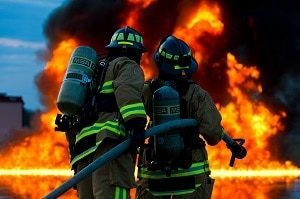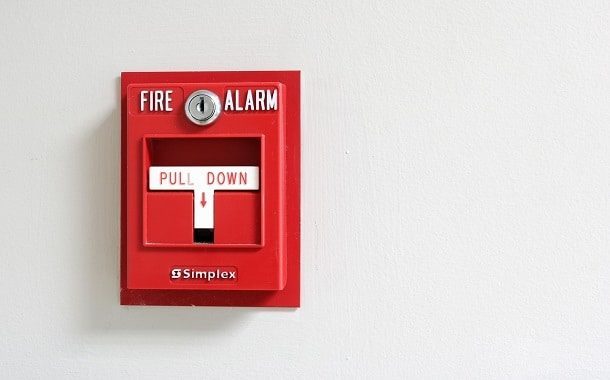How Much Does a Commercial Fire Alarm System Cost?
Last Updated on March 3, 2024
Written by CPA Alec Pow | Content Reviewed by ![]() CFA Alexander Popinker
CFA Alexander Popinker
Having a properly functioning fire alarm system is absolutely crucial for any commercial property. Not only can it save lives and prevent injuries by quickly detecting fires, but in many jurisdictions it is required by law.
However, installing and maintaining these life-safety systems does come at a cost. In this guide, we will break down the key factors that influence the pricing for commercial fire alarms and provide tips on how organizations can budget for this critical investment in safety.
A commercial fire alarm system typically includes components like smoke detectors, heat detectors, pull stations, alarm panels, horns, strobes, and wiring.
When any of these devices are triggered, the system sends a signal to a monitoring center that can dispatch emergency responders. Some systems are also connected directly to the fire department. The technology has advanced in recent years to provide faster detection through addressable and intelligent devices.
While the exact costs will vary based on the building, the type of system, and local regulations, installing and maintaining fire alarms represents a key safety investment for a commercial property. The peace of mind and level of protection provided makes it well worth the expense.
How Much Does a Commercial Fire Alarm System Cost?
The upfront costs to purchase and install a new fire alarm system for a commercial building can range from $1,500 for a basic system up to $100,000 for a large building with advanced systems. Factors impacting the price include:
- Building size and layout – Systems for larger facilities with more detection devices and wiring will cost more. Complex layouts also raise costs.
- Type and capabilities of system – More advanced addressable and intelligent systems cost more than basic conventional systems.
- Required coverage and density – More detection devices to meet safety codes raise costs.
- Additional safety capabilities – Integration with other systems like sprinklers and smoke control drives up pricing.
- Professional installation – Labor, testing, and certification services are typically $15-$50 per hour. Complex projects take more time.
Expect to pay $3-$5 per square foot for a standard fire alarm system in a commercial building. High-end systems can cost $10 per square foot or more.
Security Alarm: Monitoring fees for commercial fire alarm systems typically range between $50 to $60 per month and require a multi-year contract. The cost of a basic commercial fire detection and alarm system averages around $0.50 per square foot.
According to Forbel, a traditional commercial fire alarm system can cost between $1 to $5 per square foot, with more complex systems like sprinkler systems potentially costing up to $40 per square foot. Monitoring services can add an average of around $55 per month to the overall cost.
Ackerman Security writes that the installation cost of a retrofit commercial fire alarm system project may range from $4 to $12 per square foot of coverage. Factors influencing costs include the size of the building, the complexity of the installation, and the type of equipment needed. Monitoring services typically range from $50 to $70 monthly.
Safe and Sound notes that commercial fire alarm systems may have an overall cost ranging from around $1,800 to $20,000 or more, depending on factors like building size, age, type of system, components needed, and maintenance costs. Installation costs can vary from $1 to $2 per square foot for simple installations up to $3 to $6 per square foot for more complex setups.
Butler Durrell Security says that monitoring fees for commercial fire alarm systems can range from $40 to $60 or more monthly, based on the size of the system. Compliance with state and federal building codes is crucial when choosing and maintaining a fire alarm system.
Ongoing Maintenance and Monitoring Expenses
After the initial installation, maintaining and monitoring a commercial fire alarm system involves additional ongoing costs including:
- Scheduled annual or semi-annual testing – Professional testing costs around $200-$500 per year.
- Repairs and replacements – Faulty devices or wiring issues cost around $100 per occurrence.
- System monitoring fees – Monthly fees typically $50-$100 depending on the building.
- Fire alarm panel battery replacements every 3-5 years – Approximately $500-600.
- Regular professional system inspections – Often required by local codes at $250-$500 annually.
Proper maintenance helps avoid more costly emergency repairs. Budget approximately $1,500-$2,500 in annual costs per system.
Factors Influencing Fire Alarm System Pricing
Several key factors impact the overall investment required for a commercial fire alarm system.
System Type and Technology
Conventional fire alarm systems use hardwired zones with basic detection devices. They provide simple and affordable protection.
Addressable systems enable individual identification of triggered devices, faster response, and easier troubleshooting. They cost 20-40% more but offer enhanced protection.
Intelligent, multi-criteria systems analyze data from multiple sources to speed detection. They are the most advanced and costly systems, often 40-60% more than conventional alarms.
Building Size and Complexity
Larger facilities need more detection devices, wiring, and panels. Tall buildings, those spread over larger areas, or facilities with complex layouts also raise costs significantly for materials and labor.
Compliance and Additional Considerations
Compliance with Local Fire Codes and Standards
Most jurisdictions require commercial fire alarm systems to comply with National Fire Protection Association (NFPA) standards and local fire codes. This often necessitates a higher density of detection devices. Compliance is not optional and is an important cost factor.
You might also like our articles about the cost of a fire extinguisher ball, fire hydrant, and car alarm installation price.
Integration with Other Safety Systems
Many facilities choose to integrate their fire alarms with other systems like sprinklers, emergency lighting, and automated building controls. This improves protection but adds cost for programming and connections.
Budgeting and Financial Planning
Strategies for Managing Fire Alarm System Costs
To control costs, consider a phased installation, focus first on the most essential areas, start with a conventional system, and then upgrade later as budgets allow. Preventive maintenance helps avoid more costly emergency repairs down the road.
Tips for Selecting a Fire Alarm System
 Get quotes from at least 3 providers to compare options and pricing. Prioritize certified firms with strong local reputations. Favor companies that take time to assess your facility’s unique needs and provide recommendations tailored to your building, safety goals, and budget.
Get quotes from at least 3 providers to compare options and pricing. Prioritize certified firms with strong local reputations. Favor companies that take time to assess your facility’s unique needs and provide recommendations tailored to your building, safety goals, and budget.
Final Words
Installing and maintaining fire alarm systems represent a significant, but vitally important, expense for commercial facilities. While costs can seem high, the enhanced protection and peace of mind are invaluable.
With proper budgeting and planning, organizations can make this critical investment in safeguarding their staff, visitors, and property from fire risks. Partnership with knowledgeable, experienced providers and compliance with codes allows businesses to cost-effectively meet their life safety objectives.
To explore your options and plan a commercial fire alarm system tailored to your specific requirements and budget, contact a certified local fire protection company for a consultation and quote. Your employees and customers deserve the very best protection.
Frequently Asked Questions
How long should a commercial fire alarm system last?
With proper maintenance and occasional upgrades, a high-quality commercial fire alarm system can provide reliable fire detection for 15-20 years or longer. The lifespan depends on the environment, frequency of use, quality of the components, and maintenance practices.
Parts like the fire panel, detection devices, horns/strobes, and wiring should last 10-15 years. Batteries and ancillary components get replaced more frequently. With routine testing and repairs, commercial fire alarm systems can remain in service for decades.
How much does a new fire alarm panel cost?
For a small to medium commercial facility, a new fire alarm control panel costs $1,500 to $3,500 on average. For a large building, new fire alarm panels range from $4,000 to $10,000 or more.
The panel pricing depends on size and complexity, the number of detection devices, extra modules and functionality, enclosure requirements, and labor to install and program.
Advanced addressable or networkable panels cost significantly more than basic models. Purchasing a replacement panel from the existing manufacturer often costs less than switching brands.
How loud is a commercial fire alarm?
Commercial fire alarm notification devices must produce a sound level at least 15 decibels above ambient noise levels or exceed 75-90 decibels in general occupied areas.
For sleeping areas like hotels, the alarms sound at 110 decibels minimum to help awaken occupants. The loud, piercing sound from horns and bells ensures alerts are audible even over background noise, machinery, or from far away in large facilities.
While necessary, the noise levels contribute to the urgency and disruption during fire alarm activations.


It’s interesting to know that a commercial fire alarm system can have a very varied price range. My mother is thinking about opening a small restaurant after she retires from her current job so a fire alarm is an important things to consider for such a business. Her first love has always been cooking and it’s nice to know that she’s making plans to have more time to cook despite her old age.